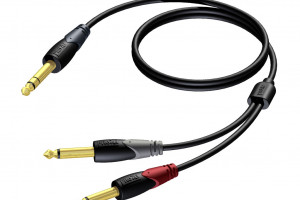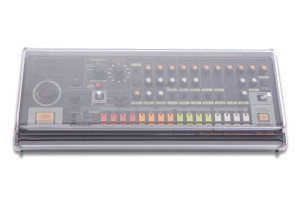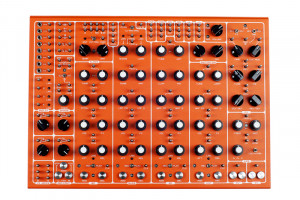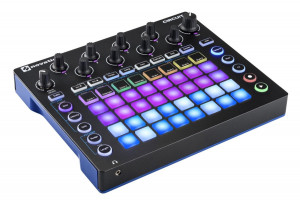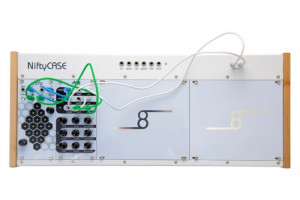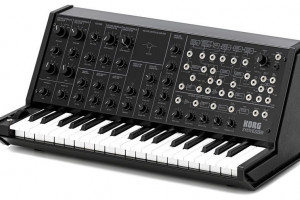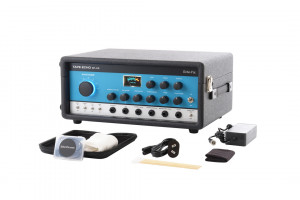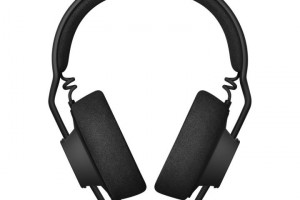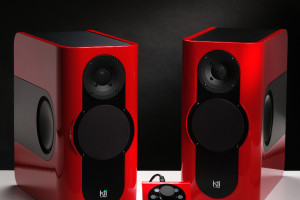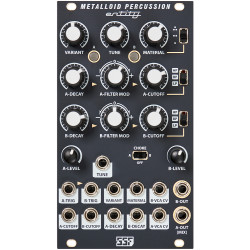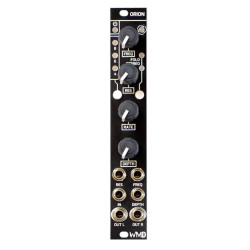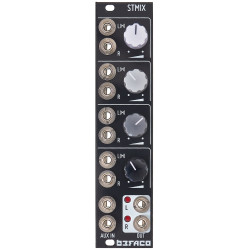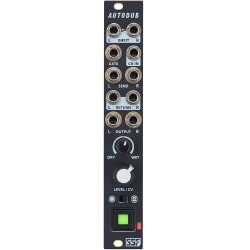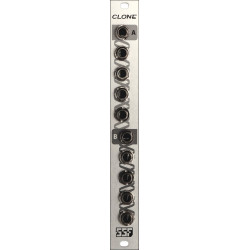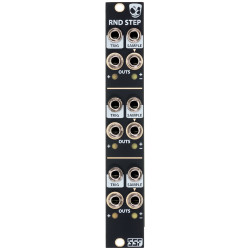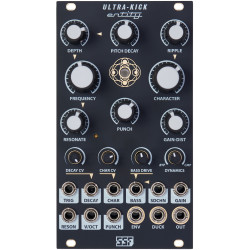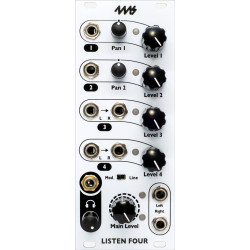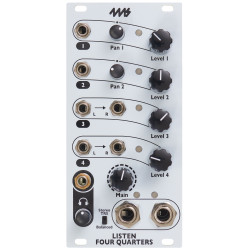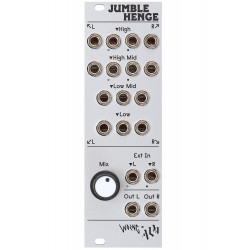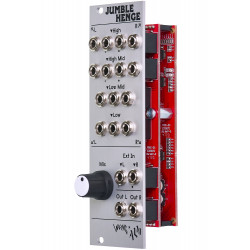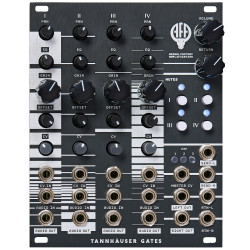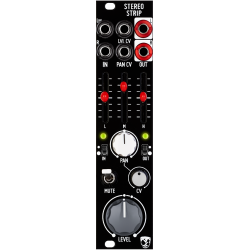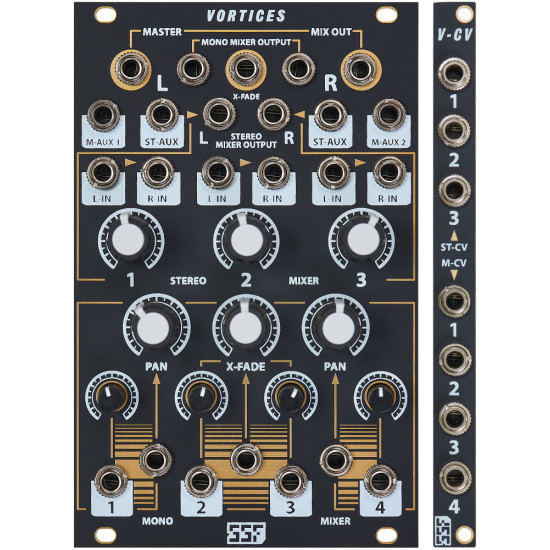
- Stock: In Stock
- Model: STEADY-STATE-SAFE-VORTICES
More from this brand
14input/7output Character Mixer
Vortices is an audio character mixer designed to emulate and accentuate the saturation-compression effects and frequency response of vintage analog consoles and tape machines. Featuring a total of 14 inputs and 7 outputs in a relatively compact 16hp form factor (18hp with VCA CV expander).
The characteristic ‘warm’ and 'round' coloration effect results is a smoother, pleasing sound with emphasis on low and mid frequency saturation, distortion and gain, with a reduced harshness of higher frequency components from the source material.
Design Inspiration:
The major intention was to make a mixer that can accommodate mono and stereo sources. With the focus on running mono signals into stereo FX and feeding them back into the mixer.
The color was of course inspired by vintage analog gear - mainly the freq response of vintage consoles and how they tend to de-emphasize higher frequencies and produce a rounder tone. I find this to be really nice for reducing harshness from FM’d and digital source material - and makes them sound smoother and less fatiguing on the ear. This type of response also lends itself to feedback patching – where higher frequency roll off is desired.
The saturation/compression/limiting aspect was inspired in the vein of processing a signal through a vintage console into an analog tape machine. Intending to add slight warmth to more extreme saturation compression. This has a big effect on tonality and tends to push the low-mid range while the built in hard limiter adds hi-mid crunch.
Overall the mixer can be used for standard mixing but is more focused on adding character and variation in sound processing applications, including more complex fx chains, feedback patching and distortion, and adding punch and smoothing harsh signals.
FEATURES/LAYOUT:
Vortices accommodates mono and stereo sources, broken respectively into two mix bus sections, each with separate mix outputs as well as a main ‘Master Mix’ split stereo output and a Master Stereo jack output on the back of the module. Separate outputs and auxiliary inputs are provided to accommodate effect chains, feedback patching and end of chain mixing solutions.
The two mixer sections offer two types of coloration and frequency response.
The main Mono Mix channels provide a warmer over-driven sound with a more pronounced high frequency reduction and rounder tonality. Higher set gain and input levels pronounce the characteristic saturation-compression effect, thereby beefing up low to mid harmonic content. Inputs will eventually hit a peak limiter, providing additional distortion at 12Vpp.
Auxiliary Mono mix inputs bypass the saturation-compression in exchange for the hard peak limiter (12Vpp) with a reduction in high frequency response.
The direct X-Fade breakout provides the same saturation-compression without the reduced high frequency response of the main outputs. (more about the breakout described in the Mono Mixer section, below.)
The main Stereo Mix channels provide a gentler saturation effect and a brighter overall frequency response (when the Stereo Mixer bus Output is utilized). These channels can also be driven harder into their respective peak limiters (12Vpp).
Auxiliary Stereo mix inputs bypass the saturation-compression in exchange for the hard peak limiter (12Vpp).
The headroom of all final mix outputs are approximately 23Vpp before additional clipping
of the summed mix occurs.
MONO MIXER:
INPUTS:
The Mono Mix bus features 4 main mono inputs, each with a level/saturation control.
Nominal volume level is set between 12-2 O'clock and saturation level can be increased beyond this point.
Inputs 1 & 4 feature manual and voltage control over stereo panorama.
Inputs 2 & 3 feature manual and voltage controlled cross-fading.
Both panning and cross-fading feature a unique linear pan law, producing a minimal -1.3dB
center dip.
Two additional auxiliary mono inputs with a -3dB pad are also provided on the mono bus to accommodate direct or externally attenuated monophonic sources.
OUTPUTS:
A direct cross-fade mix breakout. Patching out here removes the cross-fade section from the Mono and Master mix outputs.) This breakout accommodates patching back into inputs 1 or 4 for panning or for direct use/patching out of the cross-fade channels 2 & 3.
A split stereo output finalizes the Mono Mixer section.
STEREO MIXER:
INPUTS:
The Stereo Mix bus features 3 main (L>R normalized) stereo input channels with attenuation and gain. A less pronounced saturation-compression effect compared to the mono mixer.
Nominal level control is set around 3 O'clock with additional gain available beyond this point.
A split stereo (L>R normalized) auxiliary input with a -3dB pad is also provided on the Stereo bus to accommodate direct stereo or monophonic sources.
OUTPUTS:
A split stereo output with an overall brighter frequency response finalizes the Stereo Mixer section.
MASTER MIX:
A final Master Mix split stereo output provides the sum of all inputs of the Mono and Stereo Mixer sections.
AMP 'BIASING' FEATURE:
The biasing feature is inspired by class-A tube/transistor amplifiers. Biasing is a symmetry adjustment that sets the quiescent operating point of a tube/transistor in order to achieve a linear response with least distortion. By increasing the bias (DC offset) a tube/transistor can be pushed into asymmetrical saturation. While Vortices already provides enough gain to produce saturation/compression on its own, the output is symmetrical as long as the input signal is also completely symmetrical about 0V ie, +/-5V is symmetrical while +6V/-4V is asymmetrical.
The tonality of symmetrical saturation/compression exhibits a dominance of odd order harmonics. However, if one half of a waveform saturates more than the opposite half, in an asymmetrical manner, this produces an increased level of even ordered harmonics.
Vortices can produce asymmetrical saturation/compression when the input source is biased (offset) with a positive or negative DC voltage. This is accomplished by using an external CV processor or mixer with a voltage offset adjustment or summing with an envelope or LFO for a time varying effect.
An alternative tonal structure can be achieved by patching an envelope or LFO into an unused channel of the same mix bus. In this case, the signal is clipped by the internal hard limiter and produces crunchier asymmetrical distortion effects.
In all amp biasing cases, the total output symmetry remains unaffected and therefore every channel can be biased without pushing the summed mixer outputs beyond the maximum headroom of ~23Vpp.
V-CV EXPANDER:
Included with Vortices is the optional V-CV 2hp expander. This expansion module adds voltage control of all the attenuated mixer inputs for a total of 4 mono and 3 stereo VCAs. With the expander connected, external CV sources connected to the respective channel CV inputs govern the output levels. CV level is then controlled via each channel's respective attenuator.
A Master Mix Stereo jack is located on the back of the module to normalize the stereo master mix to other manufacturer's current designs and future SSF modules that utilize this feature.
-285x169.png)
